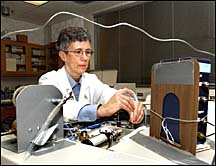|
|
|
|
|
September 26, 2003Isotope spectrometer available to campus scientists
The food scientist wants to follow a cholesterol molecule through the body. The archeologist wants to trace food on ancient pottery back to the plant or animal it once was. The environmentalist wants to know if a speck of air pollution started out as automobile exhaust. All three can look to the same hunk of high-tech equipment for answers. Its scientific name is a mouthful -- the "isotope ratio mass spectrometer." Mercifully, there's an acronym ("IRMS") for the versatile research tool that is part of the Mass Spectrometry Unit in the Human Nutrition Sciences Building. Technically part of the Center for Designing Foods to Improve Nutrition, the mass spectrometer is available to other scientists, both on- and off-campus, said Murray Kaplan, professor in charge of the spectrometer unit. The IRMS analyzes carbon, nitrogen, hydrogen and oxygen isotopes, Kaplan said. Isotopes are atoms that don't have the usual balanced complement of protons, neutrons and electrons. Isotopes are abundant in nature and "stick out" enough from their fellow atoms to be identified by a mass spectrometer. Once researchers know the ratio of isotopes in given substances, they can do a lot of scientific detective work with the IRMS, Kaplan said. For example, isotope ratios can help identify where the grapes for certain wines were grown, where migratory birds were bred, or what the climate was like eons ago. Researchers routinely use isotopes as markers in experiments, said assistant scientist and mass spectrometrist Jeanne Stewart. For example, a researcher might attach isotopes to food samples to trace glucose or starches as they move through the body. Technical information about the Mass Spectrometry Unit at Iowa State is available at http://www.cdfin.iastate.edu/massspectrometry.htm There is a fee for using the isotope ratio mass spectrometer, based on costs for supplies, labor and use of facilities. For estimates, contact Stewart, jws1@iastate.edu, 4-3926. |
|
Ames, Iowa 50011, (515) 294-4111 Published by: University Relations, online@iastate.edu Copyright © 1995-2003, Iowa State University. All rights reserved. |
